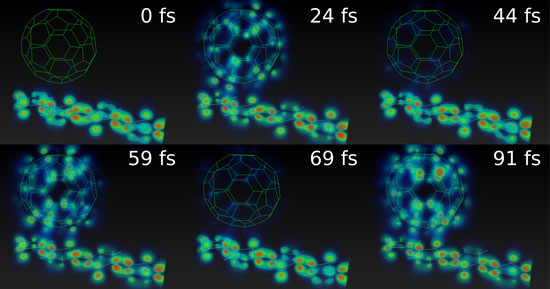| May 30, 2014 |
The quantum mechanisms of organic devices for alternative solar panels are revealed
|
|
(Nanowerk News) Silicon panel-based technology requires a very costly, contaminating manufacturing process, while organic photovoltaic (OPV) devices have been positioned as one of the most attractive alternatives as a source of solar energy.
|
|
This research has made a ground-breaking discovery because it is the first time that the quantum mechanisms that trigger the photovoltaic function of these devices have been deciphered. Angel Rubio, Professor of Condensed Matter Physics at the Faculty of Chemistry of the UPV/EHU-University of the Basque Country, director of the Nano-Bio Spectroscopy Group, and associate researcher of the Donostia International Physics Center (DIPC), has participated in the research conducted in this field in collaboration with various centres in Germany, Italy and France. The research is being published in the prestigious journal Science ("Coherent ultrafast charge transfer in an organic photovoltaic blend").
|
 |
| Photos of the simulation of the evolution in the transfer of charge from the polymer to the fullerene in femtoseconds
|
|
These organic devices use a photosensitive polymer linked to a carbon nanostructure that functions as a current collector. When light falls on the device, the polymer traps the particles of light and induces the ultrafast transmission of electrons to the nanostructure through an electron impulse in the order of femtoseconds (fs), in other words, 10-15 seconds. Evidence was recently found to confirm this ultrafast transfer, but the research of Rubio and his team has gone a step further because it has succeeded in deciphering the element mechanism that unleashes the electron transfer between the polymer and the nanostructure. The first-principal simulations in a simplified model predicted that the coherent vibrations are the ones that dictate the periodic transfer of charge between the polymer and the fullerene.
|
|
The group involved in the experiment confirmed this prediction by studying the optical response of a common material comprising a polymer and a by-product of the fullerene (a conventional nanostructure with a spherical shape) by means of high-resolution temporal spectroscopy.
|
|
The results confirmed that the coupling of the vibrations of the polymer and the fullerene bring about the electron transfer in a coherent and ultrafast way (∼23 fs), without any need to accept incoherent processes that are manifested in slower transfers (100 fs). These studies demonstrate the critical role played by quantum coherence in organic photovoltaic devices.
|
|
The research offers a vision that is consistent with element quantum processes in organic photovoltaic devices and constitutes a significant step forward in this field. “This research opens up the means for a substantial and controlled improvement in organic devices for photovoltaic applications,” pointed out Prof Ángel Rubio.
|

